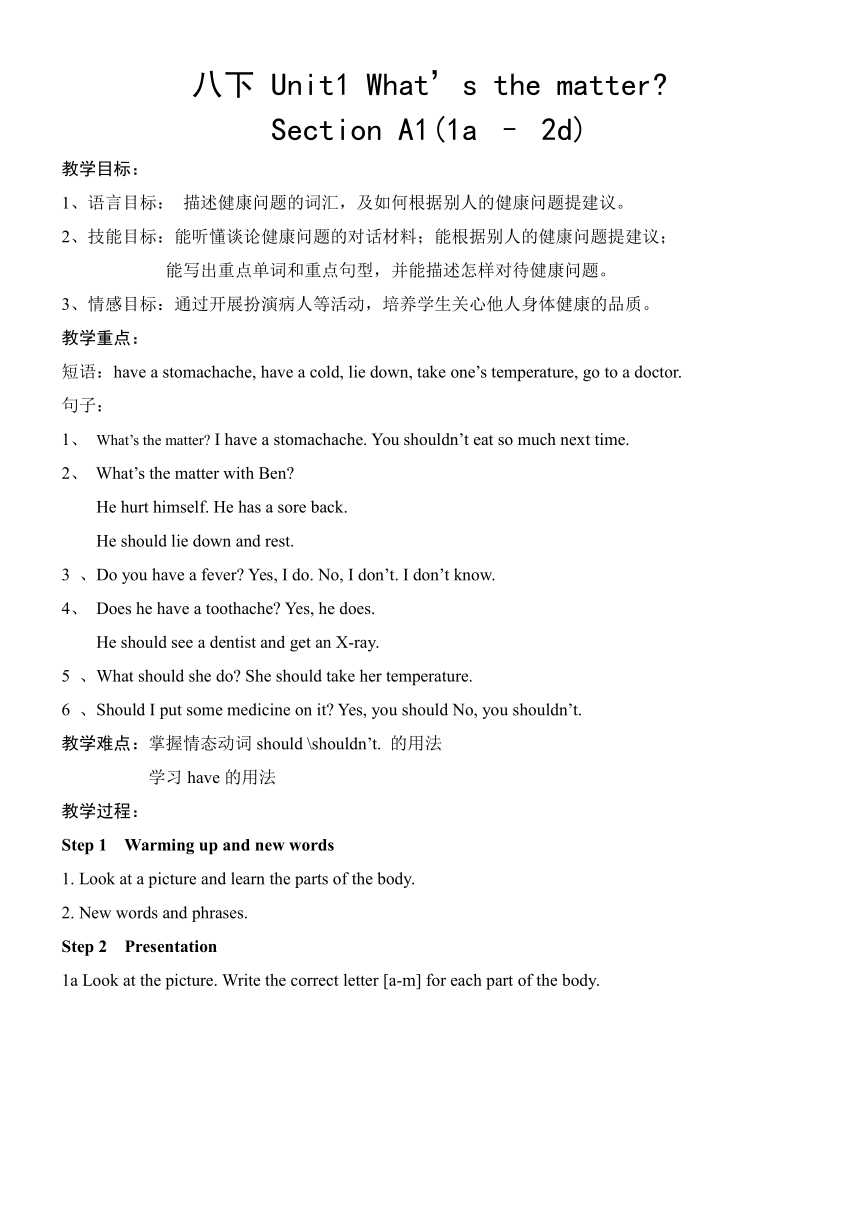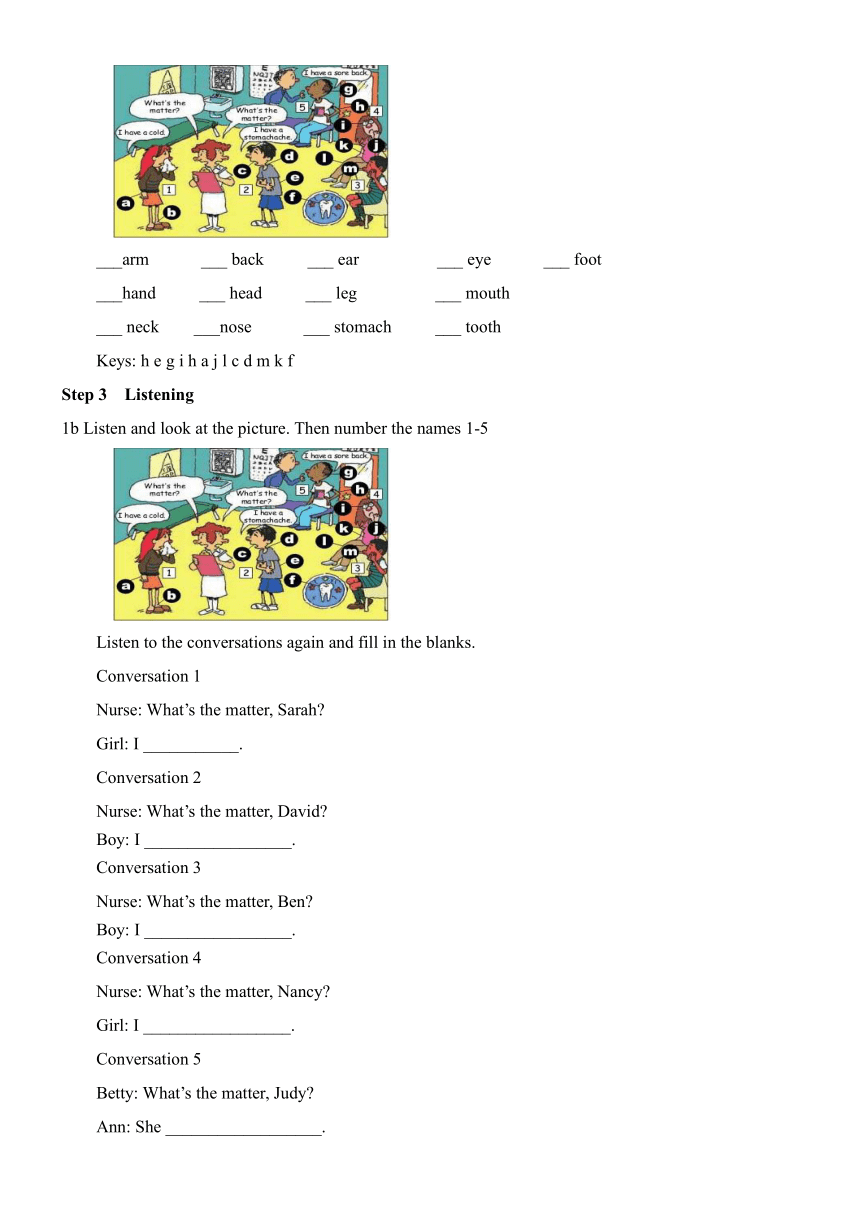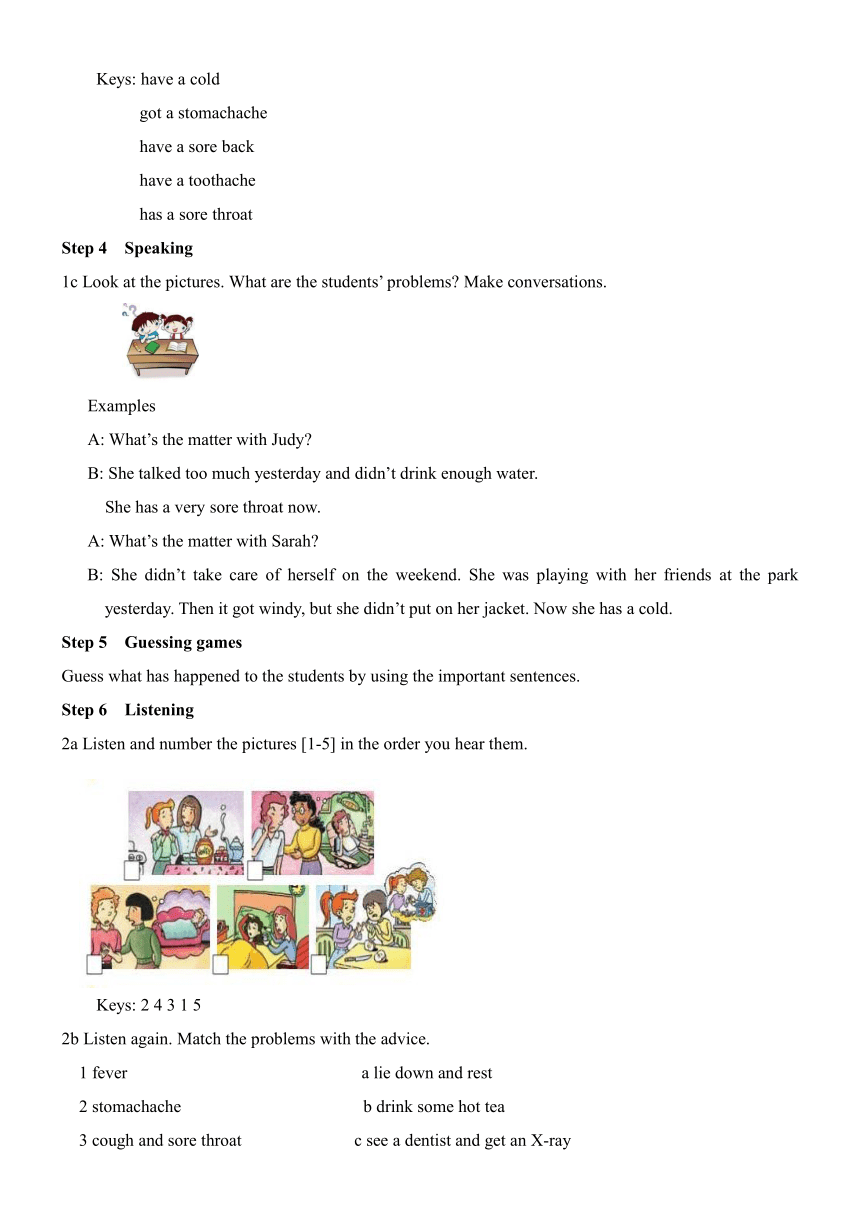人教新目标(Go for it)版 八年级下 Unit 1 What’s the matter Section A1(1a-2d)(教案)(不含音视频)
文档属性
| 名称 | 人教新目标(Go for it)版 八年级下 Unit 1 What’s the matter Section A1(1a-2d)(教案)(不含音视频) |  | |
| 格式 | doc | ||
| 文件大小 | 904.5KB | ||
| 资源类型 | 教案 | ||
| 版本资源 | 人教新目标(Go for it)版 | ||
| 科目 | 英语 | ||
| 更新时间 | 2022-03-31 15:09:43 | ||
图片预览



文档简介
八下 Unit1 What’s the matter
Section A1(1a – 2d)
教学目标:
1、语言目标: 描述健康问题的词汇,及如何根据别人的健康问题提建议。
2、技能目标:能听懂谈论健康问题的对话材料;能根据别人的健康问题提建议;
能写出重点单词和重点句型,并能描述怎样对待健康问题。
3、情感目标:通过开展扮演病人等活动,培养学生关心他人身体健康的品质。
教学重点:
短语:have a stomachache, have a cold, lie down, take one’s temperature, go to a doctor.
句子:
1、 What’s the matter I have a stomachache. You shouldn’t eat so much next time.
2、 What’s the matter with Ben
He hurt himself. He has a sore back.
He should lie down and rest.
3 、Do you have a fever Yes, I do. No, I don’t. I don’t know.
4、 Does he have a toothache Yes, he does.
He should see a dentist and get an X-ray.
5 、What should she do She should take her temperature.
6 、Should I put some medicine on it Yes, you should No, you shouldn’t.
教学难点:掌握情态动词should \shouldn’t. 的用法
学习have的用法
教学过程:
Step 1 Warming up and new words
1. Look at a picture and learn the parts of the body.
2. New words and phrases.
Step 2 Presentation
1a Look at the picture. Write the correct letter [a-m] for each part of the body.
___arm ___ back ___ ear ___ eye ___ foot
___hand ___ head ___ leg ___ mouth
___ neck ___nose ___ stomach ___ tooth
Keys: h e g i h a j l c d m k f
Step 3 Listening
1b Listen and look at the picture. Then number the names 1-5
Listen to the conversations again and fill in the blanks.
Conversation 1
Nurse: What’s the matter, Sarah
Girl: I ___________.
Conversation 2
Nurse: What’s the matter, David
Boy: I _________________.
Conversation 3
Nurse: What’s the matter, Ben
Boy: I _________________.
Conversation 4
Nurse: What’s the matter, Nancy
Girl: I _________________.
Conversation 5
Betty: What’s the matter, Judy
Ann: She __________________.
Keys: have a cold
got a stomachache
have a sore back
have a toothache
has a sore throat
Step 4 Speaking
1c Look at the pictures. What are the students’ problems Make conversations.
Examples
A: What’s the matter with Judy
B: She talked too much yesterday and didn’t drink enough water.
She has a very sore throat now.
A: What’s the matter with Sarah
B: She didn’t take care of herself on the weekend. She was playing with her friends at the park yesterday. Then it got windy, but she didn’t put on her jacket. Now she has a cold.
Step 5 Guessing games
Guess what has happened to the students by using the important sentences.
Step 6 Listening
2a Listen and number the pictures [1-5] in the order you hear them.
Keys: 2 4 3 1 5
2b Listen again. Match the problems with the advice.
1 fever a lie down and rest
2 stomachache b drink some hot tea
3 cough and sore throat c see a dentist and get an X-ray
4 toothache d take your temperature
5 cut myself e put some medicine on it
Keys: d a b c e
Step 7 Speaking
2c Make conversations using the information in 2a and 2b
A: What’s the matter
B: My head feels very hot.
A: Maybe you have a fever.
B: What should I do
A: You should take your temperature.
Step 8 Role–play
1. Imagine you are the school doctor. A few students have health problems. Role-play a conversation between the doctor and the students.
2d Role –play the conversation
2. Answer the questions.
1) What’s the matter with Lisa
2) Did she have a fever
3) What did she do the night before
4) What does she need to do
5) What should she do for now
6) What should she do if things don’t get better
Keys: She has a headache and can’t move her neck.
No, she didn’t.
She played computer games all weekend.
She needs to take breaks away from the computer.
She should lie down and rest.
She should go to a doctor.
Step 9 Language points and summary
1. What’s the matter
这是人们特别是医生和护士询问病人病情时最常用的问句, 意思是“怎么了 ”其后通常与介词with连用。类似的问句还有:
What’s wrong 怎么啦
What’s wrong with you 你怎么了
What’s your trouble 你怎么了
What’s the trouble with you 你怎么了
What’s up 你怎么了
2. have a cold伤风, 感冒, 是固定词组
表示身体不适的常用词组还有:
have a bad cold 重感冒
have a fever 发烧
have a headache 头痛
have a stomachache 肚子痛, 胃痛
have a toothache 牙痛
Summary
1. 牙疼 have a toothache
2. 胃疼 have a stomachache
3. 背疼 have a backache
4. 头疼 have a headache
5. 喉咙疼 have a sore throat
6. 发烧 have a fever
7. 感冒 have a cold
8. 躺下并且休息 lie down and rest
9. 喝热蜂蜜茶 drink hot tea with honey
10. 喝大量水 drink lots of water
11. 看牙医 see a dentist
12. 量体温 take one’s temperature
13. 看医生 go to a doctor
Step 10 Exercises
根据上下文意思填空。
Mandy: Lisa, are you OK
Lisa: I _____ a headache and I can’t move my neck. What ______ I do Should I
_____ my temperature
Mandy: No, it doesn’t sound like you have a fever. What _____ you do on the
weekend
Lisa: I played computer _____ all weekend.
Mandy: That’s probably why. You need to take breaks _____ from the computer.
Lisa: Yeah, I think I sat in the _____ way for too long without moving.
Mandy: I think you should ____ down and rest. If your head and neck still hurt tomorrow, then go to a _______.
Lisa: OK. Thanks, Mandy.
Keys: have should take did games away same lie doctor
翻译下列句子。
1. 你怎么了?我头痛。
2. 他怎么了?他发烧
3. 李雷怎么了?他喉咙痛。他应该多喝水。
4. 如果你的头和脖子明天仍然疼的话,请去看医生。
Keys:
What is the matter with you I have a headache.
What’s the matter with him He has a fever.
What’s the matter with Li Lei He has a sore throat.
He should drink lots of water.
If your head and neck still hurt tomorrow, then go to a doctor.
Step 11 Homework
Make up a conversation between a doctor and a patient.
Section A1(1a – 2d)
教学目标:
1、语言目标: 描述健康问题的词汇,及如何根据别人的健康问题提建议。
2、技能目标:能听懂谈论健康问题的对话材料;能根据别人的健康问题提建议;
能写出重点单词和重点句型,并能描述怎样对待健康问题。
3、情感目标:通过开展扮演病人等活动,培养学生关心他人身体健康的品质。
教学重点:
短语:have a stomachache, have a cold, lie down, take one’s temperature, go to a doctor.
句子:
1、 What’s the matter I have a stomachache. You shouldn’t eat so much next time.
2、 What’s the matter with Ben
He hurt himself. He has a sore back.
He should lie down and rest.
3 、Do you have a fever Yes, I do. No, I don’t. I don’t know.
4、 Does he have a toothache Yes, he does.
He should see a dentist and get an X-ray.
5 、What should she do She should take her temperature.
6 、Should I put some medicine on it Yes, you should No, you shouldn’t.
教学难点:掌握情态动词should \shouldn’t. 的用法
学习have的用法
教学过程:
Step 1 Warming up and new words
1. Look at a picture and learn the parts of the body.
2. New words and phrases.
Step 2 Presentation
1a Look at the picture. Write the correct letter [a-m] for each part of the body.
___arm ___ back ___ ear ___ eye ___ foot
___hand ___ head ___ leg ___ mouth
___ neck ___nose ___ stomach ___ tooth
Keys: h e g i h a j l c d m k f
Step 3 Listening
1b Listen and look at the picture. Then number the names 1-5
Listen to the conversations again and fill in the blanks.
Conversation 1
Nurse: What’s the matter, Sarah
Girl: I ___________.
Conversation 2
Nurse: What’s the matter, David
Boy: I _________________.
Conversation 3
Nurse: What’s the matter, Ben
Boy: I _________________.
Conversation 4
Nurse: What’s the matter, Nancy
Girl: I _________________.
Conversation 5
Betty: What’s the matter, Judy
Ann: She __________________.
Keys: have a cold
got a stomachache
have a sore back
have a toothache
has a sore throat
Step 4 Speaking
1c Look at the pictures. What are the students’ problems Make conversations.
Examples
A: What’s the matter with Judy
B: She talked too much yesterday and didn’t drink enough water.
She has a very sore throat now.
A: What’s the matter with Sarah
B: She didn’t take care of herself on the weekend. She was playing with her friends at the park yesterday. Then it got windy, but she didn’t put on her jacket. Now she has a cold.
Step 5 Guessing games
Guess what has happened to the students by using the important sentences.
Step 6 Listening
2a Listen and number the pictures [1-5] in the order you hear them.
Keys: 2 4 3 1 5
2b Listen again. Match the problems with the advice.
1 fever a lie down and rest
2 stomachache b drink some hot tea
3 cough and sore throat c see a dentist and get an X-ray
4 toothache d take your temperature
5 cut myself e put some medicine on it
Keys: d a b c e
Step 7 Speaking
2c Make conversations using the information in 2a and 2b
A: What’s the matter
B: My head feels very hot.
A: Maybe you have a fever.
B: What should I do
A: You should take your temperature.
Step 8 Role–play
1. Imagine you are the school doctor. A few students have health problems. Role-play a conversation between the doctor and the students.
2d Role –play the conversation
2. Answer the questions.
1) What’s the matter with Lisa
2) Did she have a fever
3) What did she do the night before
4) What does she need to do
5) What should she do for now
6) What should she do if things don’t get better
Keys: She has a headache and can’t move her neck.
No, she didn’t.
She played computer games all weekend.
She needs to take breaks away from the computer.
She should lie down and rest.
She should go to a doctor.
Step 9 Language points and summary
1. What’s the matter
这是人们特别是医生和护士询问病人病情时最常用的问句, 意思是“怎么了 ”其后通常与介词with连用。类似的问句还有:
What’s wrong 怎么啦
What’s wrong with you 你怎么了
What’s your trouble 你怎么了
What’s the trouble with you 你怎么了
What’s up 你怎么了
2. have a cold伤风, 感冒, 是固定词组
表示身体不适的常用词组还有:
have a bad cold 重感冒
have a fever 发烧
have a headache 头痛
have a stomachache 肚子痛, 胃痛
have a toothache 牙痛
Summary
1. 牙疼 have a toothache
2. 胃疼 have a stomachache
3. 背疼 have a backache
4. 头疼 have a headache
5. 喉咙疼 have a sore throat
6. 发烧 have a fever
7. 感冒 have a cold
8. 躺下并且休息 lie down and rest
9. 喝热蜂蜜茶 drink hot tea with honey
10. 喝大量水 drink lots of water
11. 看牙医 see a dentist
12. 量体温 take one’s temperature
13. 看医生 go to a doctor
Step 10 Exercises
根据上下文意思填空。
Mandy: Lisa, are you OK
Lisa: I _____ a headache and I can’t move my neck. What ______ I do Should I
_____ my temperature
Mandy: No, it doesn’t sound like you have a fever. What _____ you do on the
weekend
Lisa: I played computer _____ all weekend.
Mandy: That’s probably why. You need to take breaks _____ from the computer.
Lisa: Yeah, I think I sat in the _____ way for too long without moving.
Mandy: I think you should ____ down and rest. If your head and neck still hurt tomorrow, then go to a _______.
Lisa: OK. Thanks, Mandy.
Keys: have should take did games away same lie doctor
翻译下列句子。
1. 你怎么了?我头痛。
2. 他怎么了?他发烧
3. 李雷怎么了?他喉咙痛。他应该多喝水。
4. 如果你的头和脖子明天仍然疼的话,请去看医生。
Keys:
What is the matter with you I have a headache.
What’s the matter with him He has a fever.
What’s the matter with Li Lei He has a sore throat.
He should drink lots of water.
If your head and neck still hurt tomorrow, then go to a doctor.
Step 11 Homework
Make up a conversation between a doctor and a patient.
同课章节目录
- Unit 1 What's the matter?
- Section A
- Section B
- Unit 2 I'll help to clean up the city parks.
- Section A
- Section B
- Unit 3 Could you please clean your room?
- Section A
- Section B
- Unit 4 Why don't you talk to your parents?
- Section A
- Section B
- Unit 5 What were you doing when the rainstorm came
- Section A
- Section B
- Review of Units 1-5
- Unit 6 An old man tried to move the mountains.
- Section A
- Section B
- Unit 7 What's the highest mountain in the world?
- Section A
- Section B
- Unit 8 Have you read Treasure Island yet?
- Section A
- Section B
- Unit 9 Have you ever been to a museum?
- Section A
- Section B
- Unit 10 I've had this bike for three years.
- Section A
- Section B
